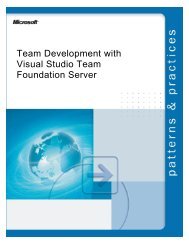CS2 Software Engineering note 3 Project Management in the ...
CS2 Software Engineering note 3 Project Management in the ...
CS2 Software Engineering note 3 Project Management in the ...
Create successful ePaper yourself
Turn your PDF publications into a flip-book with our unique Google optimized e-Paper software.
<strong>CS2</strong> <strong>Software</strong> <strong>Eng<strong>in</strong>eer<strong>in</strong>g</strong> <strong>note</strong> 3 <strong>CS2</strong>Ah 01.10.29<br />
The iteration plans usually <strong>in</strong>clude <strong>the</strong> current plan that is be<strong>in</strong>g used to<br />
manage <strong>the</strong> current iteration. This provides a framework aga<strong>in</strong>st which progress<br />
can be measured. Each iteration <strong>in</strong>cludes: Requirements, analysis and design,<br />
implementation, deployment, test, and evaluation so milestones for each activity<br />
should be established and decomposition of larger tasks <strong>in</strong>to sub-tasks should<br />
ensure <strong>the</strong> milestones are achievable. In addition, <strong>the</strong>re should be at least a<br />
plan under development for <strong>the</strong> next iteration and possibly some schedul<strong>in</strong>g of<br />
particular tasks <strong>in</strong>to later iterations. In complex systems, <strong>the</strong> early iterations<br />
may exclude much of <strong>the</strong> functionality and <strong>the</strong> iteration plans may capture <strong>the</strong><br />
“road map” of when particular features are scheduled to be <strong>in</strong>troduced.<br />
The approach to generat<strong>in</strong>g <strong>the</strong> iteration plans is entirely conventional. We<br />
identify subtasks, <strong>the</strong>ir <strong>in</strong>terdependence, and make effort estimates for each<br />
task. From this we establish start and end dates for each task that respects <strong>the</strong><br />
resource requirements we have and <strong>the</strong> dependency between tasks. This plan is<br />
usually captured by a Gantt chart show<strong>in</strong>g when each task starts and ends.<br />
<strong>Project</strong> Risk<br />
A risk comprises three elements: an undesirable event, an estimate of <strong>the</strong> severity<br />
of <strong>the</strong> consequences of <strong>the</strong> event, and a liklihood that <strong>the</strong> event will occur.<br />
The amount of risk a project is exposed to is a good measure of <strong>the</strong> viability of<br />
<strong>the</strong> project. If a project carries too much liklihood of high consequence events<br />
it should probably be cancelled because <strong>the</strong> chances of deliver<strong>in</strong>g an acceptable<br />
product are too low. Risk is often classified <strong>in</strong>to Direct risk that <strong>the</strong> manager can<br />
control to some extent and Indirect risk that <strong>the</strong> manager cannot <strong>in</strong>fluence. In<br />
manag<strong>in</strong>g a project <strong>the</strong> aim is to control risk.<br />
Risk control<br />
<strong>in</strong>volves three strategies:<br />
• Risk avoidance <strong>in</strong>volves reorganiz<strong>in</strong>g <strong>the</strong> project so you are not exposed to<br />
<strong>the</strong> risk. E.g. Change <strong>the</strong> supplier of some key component from a supplier<br />
who is promis<strong>in</strong>g a high quality product but has yet to deliver to a supplier<br />
who has a tried-and-tested product <strong>in</strong> <strong>the</strong> area.<br />
• Risk transfer <strong>in</strong>volves f<strong>in</strong>d<strong>in</strong>g o<strong>the</strong>r stakeholders to share <strong>the</strong> risk with.<br />
E.g. if you are produc<strong>in</strong>g <strong>the</strong> product for a particular customer but hope to<br />
market it to o<strong>the</strong>r customers it might be possible to share get <strong>the</strong> custome<br />
to accept more of <strong>the</strong> development costs <strong>in</strong> return for a stake <strong>in</strong> future sales<br />
to o<strong>the</strong>r customers.<br />
• Risk acceptance <strong>in</strong>volves decid<strong>in</strong>g to live with <strong>the</strong> risk and to take <strong>the</strong> occurrence<br />
of of <strong>the</strong> risk as a possible cont<strong>in</strong>gency to be taken account of <strong>in</strong><br />
<strong>the</strong> plann<strong>in</strong>g process. Accept<strong>in</strong>g a risk <strong>in</strong>volves:<br />
– Risk mitigation where we try to reduce <strong>the</strong> liklihood or <strong>the</strong> impact of a<br />
risk. E.g. if we decide to choose a particular supplier for a component<br />
3

















